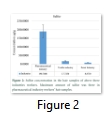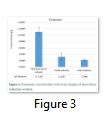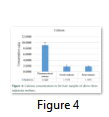Full Length Research Article
Detection and comparison of light metals in hair among workers of different industries using Particle Induced X-Ray Emission (PIXE) for forensic casework
Muhammad Rehman1, Muhammad Waqas2, Muhammad Saqib Shahzad3, Saeeda Kalsoom4, Javed Iqbal Bajwa5, Amina Arif3, Muhammad Azmat Ullah Khan3*
Adv. life sci., vol. 5, no. 4, pp. 154-157, August 2018
*- Corresponding Author: Muhammad Azmat Ullah Khan (Email: mazmatullahkhan@yahoo.com)
Authors' Affiliations
2. Department of Bioechemistry and Biotechnology (Baghdad-ul-Jadeed Campus), The Islamia University of Bahawalpur, Pakistan
3- Faculty of Life Sciences, University of Central Punjab, Pakistan
4- IMBB, University of Lahore, Pakistan
5- Punjab Medical College, Faisalabad, Pakistan
Abstract![]()
Introduction
Methods
Results
Discussion
References
Abstract
Background: The study was planned to evaluate the deposition of some metals in the scalp hair of the people working in the particular environment. Scalp hair samples were collected from different industry workers including pharmaceutical, textile and paint industry and analyzed for the determination of aluminum (Al), calcium (Ca), potassium (K) and sulfur (S). Hair analysis provides a better assessment of light metals present in the surroundings, as well as monitoring of variation of metals from place to place.
Methods: The hair samples were collected from 21-55 years old employees working in industry for more than four years. Workers of the age less than 20 years and less than 4 years working experience were not including in this study. Particle Induced X-ray Emission (PIXE) system was used to detect the light metals from hair and probable matches were searched through National Institute of Standards and Technology (NIST) library.
Results: The metals Al, S, K and Ca concentration was found maximum in the pharmaceutical industry workers. i.e., 575.1 µg/g, 190.7 µg/g, 11.1 µg/g and 9.1 µg/g respectively. The minimum concentration so these metals was found in paint industry workers i.e. 103.7 µg/g, 8.87 µg/g, 2.3 µg/g, and 1.7µg/g respectively.
Conclusion: Light metal concentrations in hair samples showed a significant positive correlation. Our findings can play vital role for health departments and industrial environmental management system (EMS) authorities in policy making and implementation. Taken all together, the workers were facing minor health implications in these industries and need immediate protective measures to remediate the current situation.
Keywords: Forensic, Scalp Hair Analysis, Particle Induced X-ray Emission
Biological samples hair, blood and urine are the most suitable tissues for diagnostic purposes and to measure the light metal concentrations leading to the point that the high exposure of toxic elements may be synergistic with risk factors [1]. Each specimen provides absolute information at elemental level [2].
Human biomonitoring is a well-recognized tool for estimating the exposure of humans to environmental pollutants [3]. With the repaid advancement in modern laboratory technologies, like Atomic absorption spectroscopy (AAS), Inductively Coupled Plasma Spectrometry (ICPS), Inductively Coupled Plasma Mass Spectrometry (ICP – MS) Inductively Coupled Plasma Optical Emission Spectrometry (ICP–OES) and Particle Induced X-ray Emission (PIXE) taking hair as a valuable specimen it has become easy to find out information about abuse drugs, toxic element exposure, important bio physiological parameters and long term nutritional status. Hair is a meaningful representative tissue according to the environmental protection agency. The toxic metals and as well as nutrients, including zinc, arsenic, lead, cadmium, selenium, antimony, mercury and copper etc. can be measured if proper washing and analysis procedure are followed [4].
The elemental concentration of metals and trace metals in different body organs is not identical but there are certain changes of element concentration in specific organs. Hair analysis evaluate the tissue storage and in many cases it is best choice when chronic exposure occurs. Hair is an excellent sample for metals analysis because the structure of hair remains unchanged and the level of trace and light metals are fixed [5].
The toxic trace metals in hair like mercury are stable over the time if the life style of the donor is not changed [6]. Long-term exposure to metals, including lead, cadmium, arsenic, and mercury, can be readily identified by hair analysis [7]. Although human biological indicators have been widely utilized for biomonitoring environmental pollutants in health exposure assessment, the relationship between internal and external exposure has not yet been adequately established [8]. Such types of studies are conducted to check the working environment and industrial hygiene practices at the work place [9].
The recommended length for the hair sample which, required for the analysis, is about one inch closest to the scalp, because of the entire hair length itself represent the history of metals contents over a period as long as 6 – 18 months. Three industries were selected to include in the research; Pacific Pharmaceutical Industry (Pvt. Ltd) 10 Km Multan road, far away from the Lahore city, Lutf Commercial Textile (Pvt. Ltd) and Brighto Paint Industry (Pvt. Ltd), Lahore.
The 5 gm scalp hair samples were collected for the PIXE analysis from 60 industrial workers working in pharmaceutical industries, textile industries and paint industries and 5 samples were collected as reference samples from the students of The University of Lahore. Before a day, all the donors were educated to wash his or her head with the Johnson baby shampoo to clean all the unnecessariness dust particles and other industrial contaminations.
The scalp hair samples were collected according to the standard protocol the hair were cut near the scalp with stainless steel scissor and stored in the air tight sterile plastic bags while paper bags were used to carry all the samples to laboratory for the further analysis, all the samples were stored in dry and cool atmosphere.
Inclusion criteria
The individuals having age from 21 – 55 years and actively working for more than four years were included in this research.
Exclusion criteria
The individuals excluded from this research were the one having age from 01 – 20 years and working in industry less than 4 years.
Particle induce x-ray emission (PIXE)
Particle Induce X-ray Emission (PIXE) system developed in 1970 by Sven Johansson of Lund University, Sweden, PIXE is more suitable analytical technique than other techniques involving the measurement of the optical radiations. Particle induce x-rays emission (PIXE) technique belong to Ion Beam Analysis, in which the specimen is used to analyze the target for a beam of accelerated particles [10].
Sample preparation for PIXE analysis
Each sample was washed to remove the external contaminants, to make pellet the samples were charred at 180oC for about 1 hour, every sample was converted into the fine powder in aluminum carbide mortar [11]. The pellet of hair samples and standard were prepared and placed on 35 nm slide for preservation until analysis.
Procedure of Particle induce X – rays Emission
The samples having pellet were irradiated with the 3.0 MeV proton beam from the 5MV Pelletron Tandem Accelerator installed at Experimental Physics Laboratory, National Center of Physics, Islamabad. The standardization and calibration of PIXE chamber for both thin (SRM2783) and thick (TiV/Fe alloy) target was carried out using NIST standard reference materials [12].
This technique has been used in forensic analysis which can measure the minute amount of sample obtained from crime scene like it can be used for segmental hair analysis, which help to distinguish that whether this exposure is exogenous or endogenous [13].
The metal analysis data was classified into three different groups i.e. Pharmaceutical, Textile, and Paint industry. All the data was analyzed for the occupational exposure industry workers to metals. The average metals contents, along with statistical parameters for donors selected from different industries are divided into three groups. Obtained data was analyzed on SPSS 21 computer bases software program.
DATA GROUP 1: Pacific Pharmaceutical Industry (Pvt. Ltd)
The level of selected metals and relevant statistical parameters for the scalp hair of male donor from the Pacific Pharmaceuticals are examined and evaluated in this study the highest value for aluminum was 969.8µg/g and the lowest 65 µg/g, calcium was 12.8 µg/g to1.4 µg/g, potassium17.1 µg/g to 1.8 µg/g and sulfur 335.4 µg/g to 6.2 µg/g. The mean for aluminum was 575.1 which shows the significant difference and having P value (p<0.05) (Fig.1), sulfur mean value was 190.7 (Fig. 2) showing the significant difference with P value (p<0.01), potassium mean value was 11.1 (Fig. 3) showing non-significant difference and P value (p>0.05) and calcium mean value was 9.1 (Fig. 4) that shows the non-significant difference and the P value (p>0.05). The following increasing order of metals level existed in employees of pacific pharmaceutical Ca˂ K˂ S˂AL.
DATA GROUP 2: Lutf Commercial Textile (Pvt. Ltd)
For the donors from the Lutf Commercial Textile, the highest concentration of aluminum was 239.7 µg/g and the lowest 30.4 µg/g, calcium 3.7 µg/g to 0 µg/g, potassium 10.1 µg/g to 0 µg/g and sulfur had the uppermost value 26.1 µg/g while lowermost value 1.1 µg/g. The arithmetic mean for the aluminum (Fig. 1) was 116.9 which shows the non-significant difference between all data groups and the P value was (p>0.05). For sulfur it was 17.7 (Fig. 2) with non-significant difference, similarly for Potassium (Fig. 3) 3.2 but for the calcium the mean value was 1.7 (Fig. 4) with the significant difference and P value (p < 0.01), the increasing order for the above metals in the textile industry was Ca˂ K˂S˂AL.
DATA GROUP 3: Brighto Paint Industry (Pvt. Ltd)
For the workers of the paint industry, the highest concentration of aluminum was 117.4 µg/g and lowest 47.6 µg/g, calcium 3.7 µg/g to1.1 µg/g, potassium 2.9 µg/g to 1.7 µg/g and sulfur 11.9 µg/g to 5 µg/g. The arithmetic mean for the aluminum was 103.7 (Fig.1) with non-significant differences and the P value (P>0.05), for sulfur it was 8.87 (Fig. 2) with non-significant difference and the P value (P>0.05), potassium was 2.3 (Fig. 3) with non-significant
difference and the P value (p >0.05) but on the other hand the calcium (Fig. 4) had the arithmetic mean value 1.7 and significant difference with the P value (p<0.01). Which shows the good variations in metal concentration between all the employees working in Brighto Paint Industry.
Tables & Figures
The pharmaceutical industry contains high aluminum contents (575.1 ± 124) as compare to the other industries and lower aluminum contents (103.7 ± 8.1) in paint industry was observed. As the aluminum metals is used in the production of different medicine [14]. Having more aluminum metal exposure to the employees in pharmaceutical industries, there were significant difference observed in aluminum level in all industries as p<0.05. The pharmaceutical industry contains high sulfur contents, (190.7 ± 37.6) as compare to the other industries because sulfur is used as active ingredients in many pharmaceutical processing [15]. But at the opposite side the sulfur concentration is lower in paint industry, (8.87 ± .87), which show that there is significant differences observed in sulfur level in all industries as p < 0.05.
The potassium level (11.1 ± 4.55) in pharmaceutical industry was high than other industries but potassium level in paint industry was lower, (2.3 ± .242) than all three industries. Because potassium was in highly amount in the processing area indicating that the individuals working in pharmaceutical industry persist potassium in their hair [16]. Significant difference was observed in potassium level in all industries as p < 0.05. The high calcium level (9.1 ± .972) was observed in pharmaceutical industry as compare to paint and textile industry and lower level was in the paint industry (1.7 ± .289) because calcium is being used as an active ingredient in the pharmaceutical products, the calcium metal was observed high in amount in the hair samples of employees of the pharmaceutical industry, significant difference was observed in calcium level in all three industries as p<0.05 [17].
These results indicate that the industrial activities primarily contribute to the metal pollution and indirect metals accumulation in hair [18]. The high exposure of toxic elements is synergistic with risk factors associated with hypertension [1]. Simillar type of the research was conducted in Ningbo, China in order to find out the status of metal pollutionand a significant positive correlation was found in the heavy metal concentrations in biological matrices and dust samples [19,20]. The results show the need for immediate improvements in workplace, ventilation, and industrial hygiene practices [9]. The deregulated metal concentrations can be a consequence of the degenerative body processes [21].
Although the metals selected in the study play important role as cofactors of different enzymes function in vital processes of the human body but after analyzing all the data from three manufacturing industries it is concluded that the workers are facing serious health implications and need immediate protective measures. Our findings are in agreement with the already conducted research on other metals and industries.
Authors declare that there is no conflict of interest for publishing this study.
- Afridi HI, Kazi TG, Talpur FN, Arain S, Arain SS, et al. Distribution of arsenic, cadmium, lead, and nickel levels in biological samples of Pakistani hypertensive patients and control subjects. Clinical Laboratory, (2014); 60(8): 1309-1318.
- McPhillips MA, Strang J, Barnes TR. Hair analysis: new laboratory ability to test for substance use. The British Journal of Psychiatry, (1998); 173(4): 287-290.
- Bibi M, Hashmi MZ, Malik RN. The level and distribution of heavy metals and changes in oxidative stress indices in humans from Lahore district, Pakistan. Human & Experimental Toxicology, (2016); 35(1): 78-90.
- Houk RS. Mass spectrometry of inductively coupled plasmas. Analytical Chemistry, (1986); 58(1): 97A-105A.
- Stadlbauer C, Prohaska T, Reiter C, Knaus A, Stingeder G. Time-resolved monitoring of heavy-metal intoxication in single hair by laser ablation ICP–DRCMS. Analytical and bioanalytical chemistry, (2005); 383(3): 500-508.
- Airey D. Mercury in human hair due to environment and diet: a review. Environmental Health Perspectives, (1983); 52303.
- Rivlin RS. Misuse of hair analysis for nutritional assessment. The American Journal of Medicine, (1983); 75(3): 489-493.
- Xing R, Li Y, Zhang B, Li H, Liao X. Indicative and complementary effects of human biological indicators for heavy metal exposure assessment. Environmental Geochemistry and Health, (2017); 39(5): 1031-1043.
- Afridi HI, Talpur FN, Kazi TG, Kazi N, Arain SS, et al. Estimation of calcium, magnesium, cadmium, and lead in biological samples from paralyzed quality control and production steel mill workers. Environmental Monitoring and Assessment, (2015); 187(6): 350.
- Vadrucci M, Bazzano G, Borgognoni F, Chiari M, Mazzinghi A, et al. A new small-footprint external-beam PIXE facility for cultural heritage applications using pulsed proton beams. Nuclear Instruments and Methods in Physics Research Section B: Beam Interactions with Materials and Atoms, (2017); 406: 314-317.
- Zucchiatti A, Galán P, Prieto JE. A procedure to correct for target thickness effects in heavy-ion PIXE at MeV energies. Nuclear Instruments and Methods in Physics Research Section B: Beam Interactions with Materials and Atoms, (2017); 407: 1-4.
- Cloete K, Šmit Ž. A Nuclear Analytical Method for Unravelling Elemental Profiles in Human Scalp Hair. Marie Curie Alumni Association, 59.
- Ozdemir S, Kilinc E, Celik KS, Okumus V, Soylak M. Simultaneous preconcentrations of Co2+, Cr6+, Hg2+ and Pb2+ ions by Bacillus altitudinis immobilized nanodiamond prior to their determinations in food samples by ICP-OES. Food chemistry, (2017); 215447-453.
- Vandenbroucke B, Kruth J-P. Selective laser melting of biocompatible metals for rapid manufacturing of medical parts. Rapid Prototyping Journal, (2007); 13(4): 196-203.
- Grodowska K, Parczewski A. Organic solvents in the pharmaceutical industry. Acta Poloniae Pharmaceutica, (2010); 67(1): 3-12.
- Saghazadeh A, Rezaei N. Systematic review and meta-analysis links autism and toxic metals and highlights the impact of country development status: Higher blood and erythrocyte levels for mercury and lead, and higher hair antimony, cadmium, lead, and mercury. Progress in Neuro-Psychopharmacology & Biological Psychiatry, (2017); 79(Pt B): 340-368.
- Yu X, Chen B, He M, Wang H, Tian S, et al. Facile Design of Phase Separation for Microfluidic Droplet-Based Liquid Phase Microextraction as a Front End to Electrothermal Vaporization-ICPMS for the Analysis of Trace Metals in Cells. Analytical Chemistry, (2018).
- Zhu Y, Wang Y, Meng F, Li L, Wu S, et al. Distribution of metal and metalloid elements in human scalp hair in Taiyuan, China. Ecotoxicology and Environmental Safety, (2018); 148538-545.
- Li Z, Su H, Wang L, Hu D, Zhang L, et al. Epidemiological Study on Metal Pollution of Ningbo in China. International Journal of Environmental Research and Public Health, (2018); 15(3).
- Junaid M, Hashmi MZ, Malik RN. Evaluating levels and health risk of heavy metals in exposed workers from surgical instrument manufacturing industries of Sialkot, Pakistan. Environmental Science and Pollution Research, (2016); 23(18): 18010-18026.
- Bocca B, Forte G, Oggiano R, Clemente S, Asara Y, et al. Level of neurotoxic metals in amyotrophic lateral sclerosis: A population-based case-control study. Journal of the Neurological Sciences, (2015); 359(1-2): 11-17.
This work is licensed under a Creative Commons Attribution-Non Commercial 4.0 International License. To read the copy of this license please visit: https://creativecommons.org/licenses/by-nc/4.0







